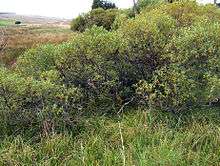Salix pentandra
| Salix pentandra | |
|---|---|
 | |
| Bay willow with early autumn colours, Kielder, Northumberland | |
| Scientific classification | |
| Kingdom: | Plantae |
| Clade: | Angiosperms |
| Clade: | Eudicots |
| Clade: | Rosids |
| Order: | Malpighiales |
| Family: | Salicaceae |
| Genus: | Salix |
| Species: | S. pentandra |
| Binomial name | |
| Salix pentandra | |
Salix pentandra, the bay willow, is a species of willow native to northern Europe and northern Asia.[1]
.jpg)
It is a large shrub or small tree growing to 14 m (46 ft) tall (rarely to 17 m), usually growing in wet, boggy ground. The leaves are glossy dark green, 5–12 cm long and 2–5 cm broad, with finely serrated margins. The dioecious flowers are catkins, produced in late spring after the leaves; the male catkins are yellow, 2–5 cm long, the female catkins greenish, 1.5–3 cm long; they are pollinated by bees. The fruit is a small capsule containing numerous minute seeds embedded in white down which aids wind dispersal.[1][2]
The scientific name refers to the male flowers having five stamens. The English name derives from the resemblance of the leaves to those of the bay laurel; other common names include bay-leaved willow and laurel willow. Its glossy leaves make it more decorative than many other willows, so it is often planted as an ornamental tree.[1]
It has become locally naturalised in northern North America, and is known as laurel willow there.[3]
References
- 1 2 3 Rushforth, K. (1999). Trees of Britain and Europe. Collins ISBN 0-00-220013-9.
- ↑ Mitchell, A. F. (1974). A Field Guide to the Trees of Britain and Northern Europe. Collins ISBN 0-00-212035-6
- ↑ "Salix pentandra". Natural Resources Conservation Service PLANTS Database. USDA. Retrieved 27 October 2015.
| Wikimedia Commons has media related to Salix pentandra. |